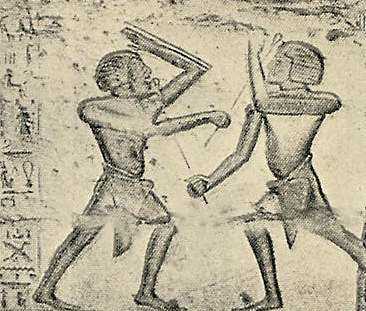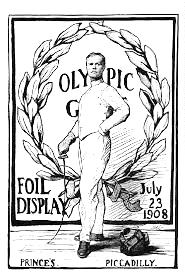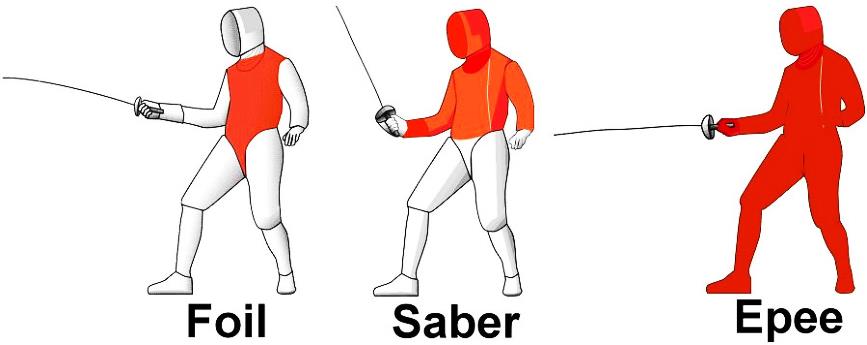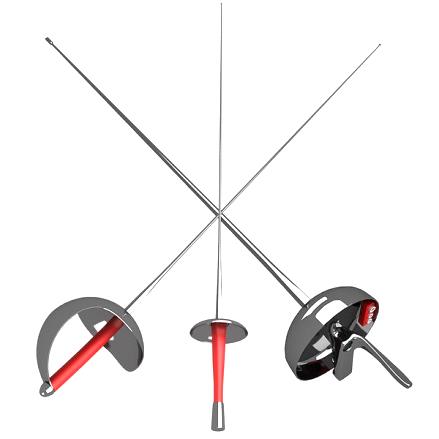Fencing:
The Oldest, Modern Sport!

Murals from ancient Egypt have depicted scenes of athletes competing with swords. Thus, fencing has endured and evolved throughout virtually all of man’s historical existence. It is a martial (combat related) sport, but is the most elegant and most intellectual of all such sports.
For many years, the sport was practiced to hone the skills of warriors who would use the techniques and tactics developed during the practice for actual combat. With the advent of gunpowder and other modern military weapons, the sword and the practice of sword fighting have been relegated to a purely athletic exercise.
While there are enclaves of practitioners who practice sword fighting as historical recreations, or who fight for first blood, the vast majority of sport fencers in the world follow the standard rules set down by the International Fencing Federation (FIE) and used in competitions at local fencing clubs up to the Olympics.

As an organized sport, fencing is one of four sports to have been included throughout the entire modern Olympic movement that started in 1896. Only recently in the 2004 Olympics was all six disciplines – foil, sabre and épée for both men and women – included in the sport.
Fencing is primarily an individual sport. A competition comprises of a group of fencers (entrants) who are separated into groups of six or seven. The fencers compete against everyone else in their group. The fencers’ results in this preliminary portion of the competition are used to seed the fencers into a direct-elimination format. The top-seeded fencers are opposed by the bottom-seeded fencers and winners continue up the direct elimination table while losers are eliminated from competition.

In some cases fencers compete in team format. A team is comprised of three fencers. Each of the three fencers from one team will compete against the three fencers from another team (substitutes are allowed, but fencers subbed out cannot return) in a relay format. That is, the first pair of opponents compete to be the first to get to five points. Once that is achieved (or time has expired), the next pair of opponents battle to ten points (or until time expires) and so on until one team reaches 45 points first, or is in the lead at the end of time. Team competitions are often very spirited.
FENCING WEAPONS
FOIL
The foil is a light weighted weapon that hits by thrusting the tip at the opponent. The target for foil is just the torso, excluding all extremities.
Offense is performed by thrusting the weapon at the torso, intending to hit only with the tip (hitting with the side of the blade yields no points). Defense is performed by using evasion (moving to avoid the thrust) and deflection of the opponent’s attacks with one’s own weapon.
The modern foil has a small round guard, a flexible blade with a rectangular cross-section, and usually equipped with a pistol grip.
Foil tactics use a balance of offensive and defensive feints and actions to set up openings for a score.
SABRE
The modern sport of sabre allows hits by both thrusting and cutting. The target in sabre is any part of the body above the waist.
Offense is performed by either thrusting or cutting (slashing) at the opponent. Defense is performed by evading the hits (primarily by stepping back) and by blocking or deflecting the opponent’s attack with the saber.
The modern sabre has a whippy blade with a distinctive edge and flat portion. The guard includes a knuckle guard unlike the foil or épée. The grip is a slightly curved hilt with no extraneous prongs or hooks.
Sabre tactics favor the attacker who has a greater success at scoring than the defender has at preventing a hit from occurring.
ÉPÉE
At Front Range Fencing we consider the épée to be the best weapon. The modern épée has a heavy, stiff blade with a V cross-section and a large round bell-guard to cover the hand. The target is the whole body, but can only be scored by thrusts.
Unlike foil or saber, épée does not follow the right-of-way conventions to determine who gets a point when both fencers hit. In the case of épée, if both fencers hit, both will receive a point.
Due to a lack of the right-of-way rule and the large target area, there is great uncertainty as to an opponent’s response to any offensive action. Thus, épée tactics are a balance of offensive and defensive posture.


FAMOUS FENCERS
Actors

Grace Kelly was trained to fence for her role in ‘The Swan’, Charles Vidor’s 1956 movie in which Grace Kelly played a princess who adores fencing

Jerry O’Connell, a 1995 graduate of NYU where he fenced saber, starred in his first movie, ‘Stand by Me’. After his NYU graduation, he was the lead in the T.V. show, ‘Sliders’ for five seasons and has been in films such as ‘Jerry Maguire’, ‘Scream 2’, and ‘Kangaroo Jack’.

Charlie O’Connell fenced foil for NYU and competed against Nathan Anderson in 1996 NCAA championships. Like his brother, he has been featured in television and films, including the movie “Dude, where my car?” and was recently featured in the TV show The Bachelor.

George Peppard was a fencing instructor before becoming famous in ‘Breakfast at Tiffany’s’ with Audrey Hepburn. He also starred in ‘The A-Team’ as Lt. Col. John 'Hannibal' Smith.

Robert Redford fenced his director, George Roy Hill, on the set of ‘Butch Cassidy and the Sundance Kid’ according to DVD extras.
Film

Jessica Yu, a member of the 1986 USA National Fencing Team that competed at the World Championships, won an Academy Award for her documentary Breathing Lessons: The Life and Work of Mark O'Brien. She has directed episodes of hit shows like 'E.R.' and 'The West Wing', according to www.IMDB.com.
Military

General George S. Patton Jr. competed the 1912 Stockholm Olympics in the Modern Pentathlon. He placed fifth overall. In 1913, he arrived at Mounted Service School in Fort Riley, Kansas. He became the school’s first Master of the Sword and taught classes in swordsmanship.
Music

Bruce Dickerson, the lead singer for Iron Maiden, fences and owns the British fencing equipment maker, The Duellist. Also a public speaker and pilot.

Jimmy Buffett, famous for his Margaritaville song, enjoys fencing.

Neil Diamond was a New York University saber fencer before his career as a singer.
Politicians
Harry Truman, the Unites State President, fenced in his youth in Missouri.
Theodore Roosevelt, the United State President, had said in his autobiography, “While President I used to box with some of the aides, as well as play single-stick [wood version of fencing] with General Wood.”
Winston Churchill, the famous British Prime Minister, won Public Schools Fencing championship in foil in his youth.
Writers
Ezra Pound, the famous American poet on the left, became fencing master and secretary to the great Irish Poet W. B. Yeats, on the right, after meeting him in 1912. William Butler Yeats started learning to fence at age forty-eight. Eleven years after learning to fence, Yeats won the Nobel Prize for Literature in 1923.
Rene Descartes, was a fencing master along with being a philosopher.
Alexander Dumas, the famous writer of The Three Musketeers and The Count of Monte Cristo, participated in duels. His expertise in sword fighting clearly comes through in his prose.
Writer and Explorer Richard Burton fenced, fought, and “was throughout his life an ardent student of the theory, and an acknowledged master of the practice, of the art of swordsmanship” according to the arms curator Forbes Seiveking. Some of his fame derives from his notorious for his visit to Mecca and his translation of One Thousand and One Nights.
Fencing Trivia
Fencing is one of only four sports to be included in every modern Olympic Games, since the first in 1896. Fencing was also a sport in the original Olympic Games in ancient Greece.
Baron Pierre de Coubertin, the father of the modern Olympic Games, was a fencer.
The tip of the fencing weapon is the second fastest moving object in sport; the first is the marksman's bullet.
Fencing is conducted on a 14m x 2m "strip" or "piste" to replicate combat in confined quarters such as a castle hallway. The end of the fencing strip represents the line drawn in the earth by duelists' seconds: to retreat behind this line during the duel indicated cowardice and loss of honor.
The 750 gram weight test used to ensure a touch is scored with sufficient force is based on the amount of tension required to break the skin. In a duel, honor was done when blood was first drawn -- even if from a minor wound such as a blister.
There was originally no time limit on a fencing bout, until a Masters Championship bout in New York in the 1930s lasted for seven hours. Thereafter, bouts were limited to 30 minutes. Today, the time-limit has been reduced to just 3 minutes for 5-touch bouts and 9 minutes for 15 touches.
Fencing Vocabulary
· Weapons - Foil, Epee, Sabre
· En garde/On guard - the basic stance.
· Advance - the forward movement, front foot moves first.
· Retreat - the backward movement, back foot moves first.
· Lunge - a forward body movement. In general, the hand starts extension followed by the front foot which glides just above the floor and lands on the heel. The front leg stops with the shin perpendicular to the floor, the rear leg is straight, the rear foot is flat on the floor. The torso is erect. The rear arm lowered with the palm facing up.
· Appel - a sharp slap of the front foot usually for tactical advantage.
· Balestra - a forward jump usually followed by a lunge.
· Fleche - a forward motion in which the rear foot crosses the front foot. Not allowed in sabre.
· Attack - initial offensive action, executed with arm extending and threatening the valid surface with a progressive forward motion.
· Simple attack - direct or indirect offensive action, executed in one tempo.
· Straight attack - simple direct offensive action.
· Coupe attack - simple indirect offensive action which passed from one side of the opponent’s blade to another. In high line, the coupe is accomplished by passing over the opponent’s blade. In low line, it is accomplished by passing under the opponent’s blade.
· Engage - touching of the blades on one side or another of the opponent’s blade.
· Disengage attack - simple indirect offensive action which passed from one side of the opponent’s blade to another. In high line the disengage is accomplished by passing under the opponent’s blade. In low line it is accomplished by passing over the opponent’s blade.
· Parry - defensive action made with the blade to prevent the opponent’s offensive action from arriving.
· Lateral parry - type of parry described by moving the blade in a horizontal motion.
· Circular parry - type of parry described by moving the blade in a circular motion.
· Blocking parry - defensive action with the blade that closes the defensive line securely.
· Beat parry - defensive action with the blade that deflects the opponent’s offensive action by striking it sharply.
· Opposition parry -defensive action with the blade that deflects the opponent’s offensive action without roughness and maintaining contact.
· Yielding parry -defensive action with the blade that deflects the opponent’s offensive action without roughness and maintains contact.
· Riposte - offensive action executed after a parry. It may be either simple or compound.
· Counter riposte - offensive action executed after parrying the riposte. It may be either simple or compound.
· Feint - simulation of an offensive, defensive or counter offensive action, intended to draw a reaction or the absence of a reaction from the opponent.
· Compound attack - offensive action preceded by one or more feints of the attack.
· Remise - simple direct offensive or counter offensive action made after the initial ripsote is delayed or absent.
· Reprise - simple indirect or compound offensive or counter offensive is parried, when the riposte is delayed or absent.
· Redoublement - forward confirmation with new footwork (lunge, fleche, etc.) after an initial attack is short or parried.
· Invitation - movement which voluntarily opens up the target area, and attempts to provoke an offensive action.